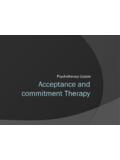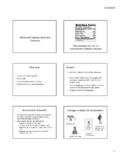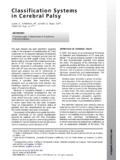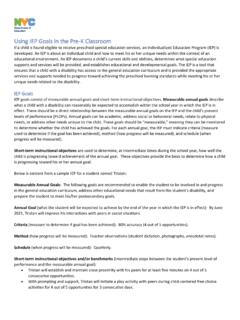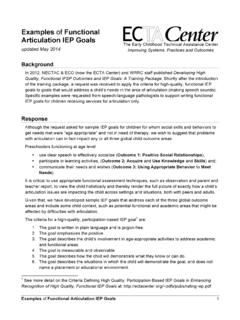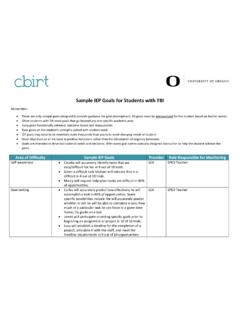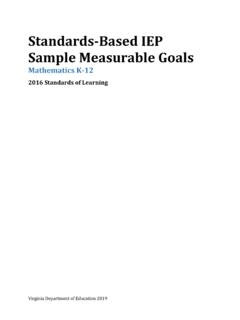Transcription of Writing IEP Goals for Emerging Communicators - OHSU
1 Based on work by Linda Burkhart & Gayle Porter Writing IEP Goals for Emerging Communicators Based on work by Linda Burkhart & Gayle Porter Beliefs & Assumptions about Communication Non-speaking Not understanding Everyone communicates > Assume potential Communication is learned in context, in real-life interactions, all day It is messy and dynamic depends on partners responses & situations Requiring too much correctness early on can derail the learning process The Challenge in School School instruction relies on students having expressive communication skills Learning (and testing) at school is decontextualized (compared to early learning) (Early) communication is learned only contextually This mismatch can lead to Goals that don t support learning communication Writing Goals Consider: 1.
2 Early communication skills are learned through experimentation and interactions via the child s own agenda. 2. Receptive skills are demonstrated through responses some children have difficulty moving their bodies and their physical responses might mask understanding. 3. Determining an appropriate communication system can take time and experimentation so, initial Goals may need to be written in a manner that allows for exploration of a range of strategies to determine the most appropriate learning requirements for each child. 4. Being too narrow in Goals (what child says, when, how many times) can lead to inappropriate instruction. Example of a Faulty Communication Goal: Based on work by Linda Burkhart & Gayle Porter During snack, _____ will request a drink 4 out of 5 times.
3 Does (s)he want a drink? How do you know if it s 4 out of 5 times? If they respond to a question about wanting a drink it is not a request, it s a response What does it teach the student if they have to request a drink and don t want one? If (s)he could say I want to play outside , would they fail the goal? Doesn t give credit for a variety of communication functions (protest, opinion, question) 5. Don t combine academic content with communication Goals . Example of a Faulty Communication Goal (combined with academic content): During math activities, ____ will respond to the question: How many? when presented with a group of 1 -10 items. If student responds with incorrect number: pass/fail this goal? Communication is successful they initiated an answer!
4 (just need to work on those numbers!) Examples of Flexible, Natural Goals for Emerging Communicators : Receptive/Modeling Goal: A. _____ will show increasing interest and attention to someone using (symbols, AAC device, etc.) to talk to him/her in natural contexts. This will be observed as an increase in: looking towards the communication symbols or the communication partner, calming during this process, looking away to the side but with a stillness as if listening, or responding to the partner (to be defined for individual child) Minimum of 10 times during the school day in a variety of contexts. How can this goal grow/be modified? Increase number of contexts in school; decrease level of prompt needed for attention; increase complexity of message modeled (number of symbols used, etc.)
5 Early Expressive Goal: B. Within natural contexts throughout the day, ____ will initiate use of (the AAC system/s) by one of the following methods: (define specifically for the child see below) and attempt to communicate something. Measured by increasing in frequency over baseline Based on work by Linda Burkhart & Gayle Porter Initiation Methods (depends on child): o Look towards AAC system/s (which should be kept within close proximity) a partner will then offer Do you have something to say? o Lift or wave arm wearing a wristband that says I have something to say o Call out or make a sound (partner offers, as above) Early Expressive Goal expanded C. ____ will intelligibly initiate communication with an expanded range of communication partners (measurement over baseline).
6 Expressive Goal: D. Within natural contexts throughout the day, _____ will use an increasing number of communicative functions expressively with AAC system/s. (Number of functions and frequency specified for child). Examples of Communicative Functions: Request objects, actions, or activities, request a turn, reject/protest, complain, respond, draw attention, comment, express opinion, ask a question, answer, greet, etc. Visual-Motor Access Goals - added by AT Lab: Access Goal for 2 switch use: E. During inclusive play/leisure activities, ____ will activate 2 (mechanical, proximity, etc.) switches with 2 distinct body parts, alternating between both with fair ease and accuracy over the course of trials each week. Access Goal for Direct finger select: F. During inclusive play/leisure activities, ___ will activate 2 cells in a field 6 on dynamic screen display with an index finger or knuckle, landing within cell boarders, activating only 1 target at a time, with fair ease and accuracy over the course of trials each week.
7 (Size and number of cells determined for each child.) Taking Data Testing situations present an artificial context and will not provide a window into the child s true developing communication skills. Goals must be measurable but don t have to be measured in a testing format. Tables that allow data to be taken at different times over a period of days, weeks, etc. may be more feasible and support communication in natural contexts. Based on work by Linda Burkhart & Gayle Porter *See Data Tables




